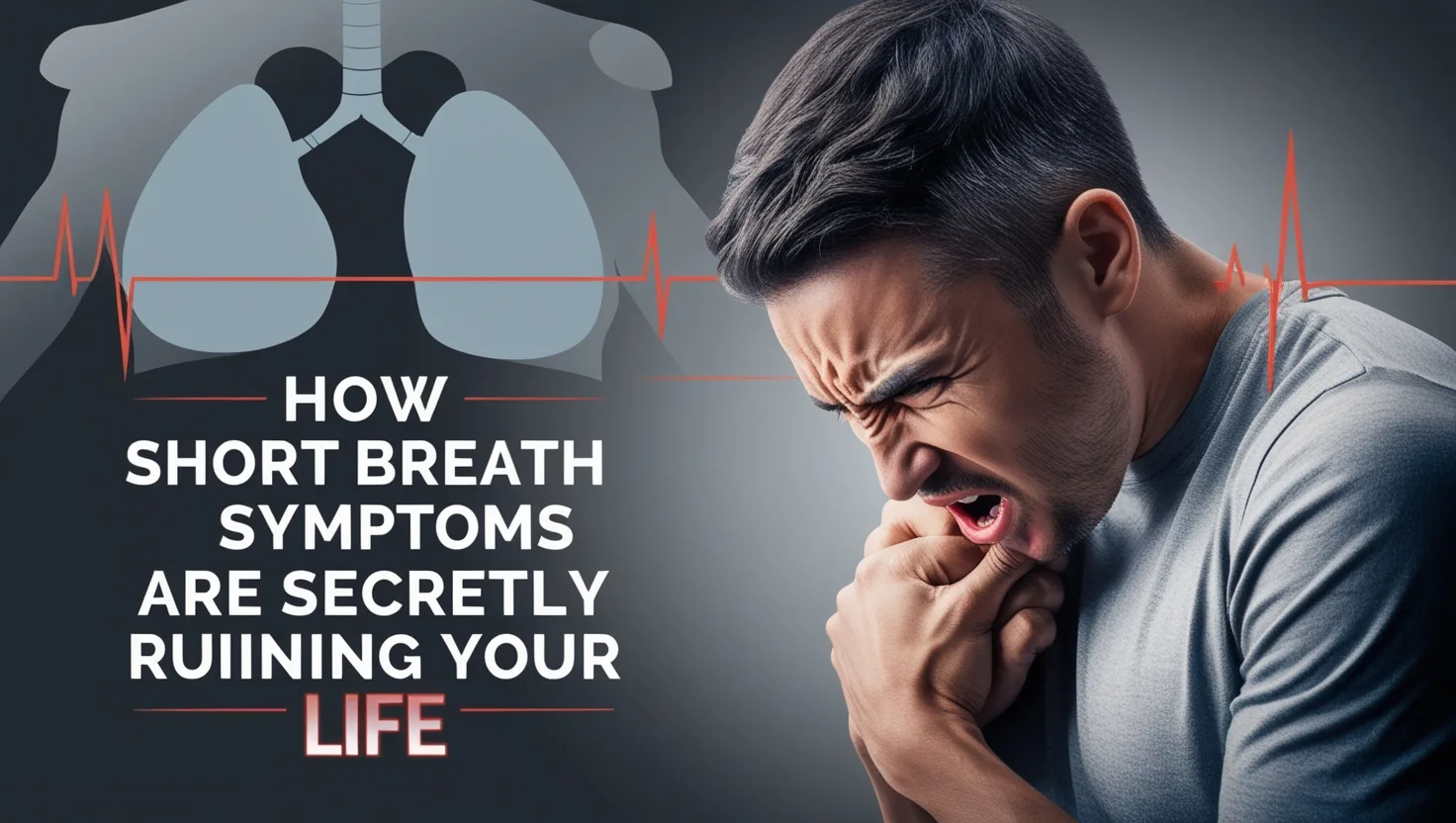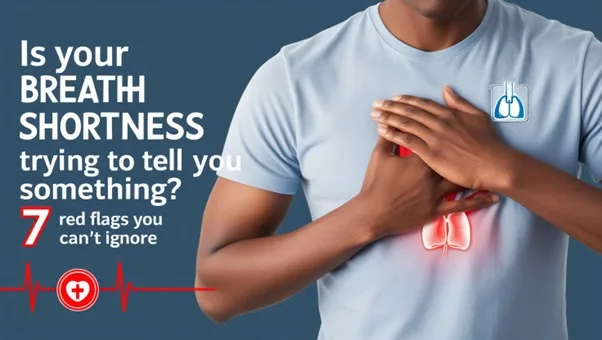Understanding of 7 Signs of Breath Shortness
What is Breath Shortness?
Breath shortness is also known as dyspnea in medical terms, which means an uncomfortable feeling of not being able to breathe easily. It’s like your lungs are working overtime, but you still can’t seem to get enough air. I remember feeling this way after running up a flight of stairs once, and it was quite scary.
Normal breathing vs. dyspnea
Normally, we breathe without even thinking about it. But when you have dyspnea, every breath becomes a conscious effort. It’s the difference between effortlessly climbing a hill and feeling like you’re scaling Mount Everest with each step.
Acute vs. chronic shortness of breath
Breath shortness can be either acute (sudden) or chronic (long-lasting). Acute dyspnea might hit you after intense exercise or during an asthma attack. Chronic dyspnea, on the other hand, is like an unwelcome houseguest that overstays its welcome, lingering for weeks or even months.
Common Causes of Shortness of Breath
Respiratory conditions
Many respiratory issues can leave you gasping for air. Asthma, chronic obstructive pulmonary disease (COPD), and pneumonia are common culprits. I once had a friend with asthma who described an attack as feeling like breathing through a straw.
Cardiovascular issues
Your heart and lungs work as a team. When one falters, the other feels the strain. Heart conditions like heart failure or coronary artery disease can make you feel short of breath, especially during physical activity.
Environmental factors
Sometimes, it’s the world around us that makes breathing difficult. Air pollution, high altitudes, or even extreme temperatures can leave us puffing and panting. I’ll never forget how hard it was to catch my breath on a particularly smoggy day in the city.

Diagnosing Breath Shortness
Medical history and physical examination
When you visit a doctor for breath shortness, they’ll likely start by asking about your symptoms and medical history. They might also listen to your lungs and heart with a stethoscope. It’s a bit like being a human radio, with the doctor tuning in to your internal stations.
Diagnostic tests and procedures
Depending on your symptoms, your doctor might recommend various tests. These could include chest X-rays, lung function tests, or blood tests. It might seem like a lot, but each test helps paint a clearer picture of what’s going on inside your body.
Identifying underlying conditions
Sometimes, breath shortness is a symptom of an underlying condition. It could be anything from anemia to anxiety. Identifying these root causes is crucial for effective treatment.
Treatment Options for Shortness of Breath
Medications and inhalers
Depending on the cause, your doctor might prescribe medications or inhalers to help you breathe easier. For some, these can be real lifesavers, providing relief when you need it most.
Lifestyle modifications
Sometimes, small changes can make a big difference. Quitting smoking, losing weight, or avoiding triggers can help manage breath shortness. It’s not always easy, but the results can be truly life-changing.
Oxygen therapy and breathing techniques
In some cases, additional oxygen might be necessary. There are also breathing techniques that can help you make the most of each breath. I once learned a technique called pursed-lip breathing, and it’s been incredibly helpful during stressful moments.
Prevention and Management Strategies for Breath Shortness
Maintaining a healthy lifestyle
Eating well, exercising regularly, and getting enough sleep can all contribute to better lung health. It’s like giving your lungs a daily spa treatment.
Avoiding triggers and irritants
If you know certain things trigger your shortness of breath, do your best to avoid them. This might mean staying indoors on high-pollen days or steering clear of strong perfumes.
Developing an action plan
Having a plan in place can help you feel more in control when breath shortness strikes. This might include knowing when to use your inhaler or when to call for help.
How Short Breath Symptoms Are Secretly Ruining Your Life

Recognizing Short Breath Symptoms
Physical signs and sensations
Shortness of breath can manifest in various ways. You might feel like you’re gasping for air, or that your chest is tight and constricted. Some people describe it as a feeling of suffocation or an inability to take a deep breath. It’s a sensation that can be truly frightening, especially when it catches you off guard.
Emotional and psychological effects
The impact of breathing difficulties extends beyond the physical. Anxiety and panic often accompany shortness of breath, creating a vicious cycle where fear of breathlessness leads to more breathing problems. I can only imagine how distressing it must be to constantly worry about your next breath.
Impact on daily activities and quality of life
Shortness of breath can significantly limit your ability to perform everyday tasks. Simple activities like climbing stairs, carrying groceries, or even having a conversation can become challenging. It’s heartbreaking to think about how many people might be missing out on life’s joys due to undiagnosed breathing issues.
Diagnosing the Underlying Causes
Medical history and physical examination
If you’re experiencing shortness of breath, your doctor will likely start by asking about your symptoms and medical history. They’ll perform a physical exam, listening to your lungs and heart. It’s crucial to be open and honest during this process, even if some of the questions seem unrelated.
Diagnostic tests and procedures
Depending on your symptoms, your doctor might recommend various tests. These could include lung function tests, chest X-rays, or even heart tests like an electrocardiogram (ECG). While these procedures might seem daunting, they’re essential for getting to the root of the problem.
Importance of early detection and intervention
Catching breathing issues early can make a world of difference. Early intervention often leads to better outcomes and can prevent further complications. It’s a reminder of how important it is to listen to our bodies and seek help when something doesn’t feel right.
Treatment Options for Short Breath
Medications and therapies
Treatment for shortness of breath varies depending on the underlying cause. It might involve inhalers for asthma, oxygen therapy for COPD, or medications for heart conditions. The key is finding the right treatment plan that works for you.
Lifestyle modifications and self-management techniques
Sometimes, small changes can make a big impact. Learning breathing exercises, quitting smoking, or starting a gentle exercise routine can all help improve breathing. It’s empowering to know that we have some control over our breathing difficulties.
Surgical interventions when necessary
In some cases, surgery might be necessary to address the root cause of breathing problems. While the thought of surgery can be scary, it’s important to remember that these procedures are designed to improve your quality of life.
When to Seek Medical Help
Emergencies
If you’re struggling to breathe, experiencing chest pain, or feeling dizzy, don’t wait – seek medical help immediately. It’s always better to be safe than sorry.
Persistent symptoms
If your shortness of breath doesn’t improve or keeps coming back, it’s time to see a doctor. Your body might be trying to tell you something important.
Worsening of existing conditions
For those with chronic conditions, any worsening of symptoms should be taken seriously. It could be a sign that your current treatment plan needs adjusting.
Living with Chronic Breath Shortness
Coping strategies
Living with chronic breath shortness can be challenging, but there are ways to cope. This might involve pacing yourself, using relaxation techniques, or finding new ways to do everyday tasks.
Support groups and resources
Remember, you’re not alone. There are support groups and resources available for people living with chronic breath shortness. Sharing experiences and tips with others who understand can be incredibly comforting.
Improving quality of life
While chronic shortness of breath can be limiting, it doesn’t have to define your life. With the right strategies and support, many people find ways to enjoy a fulfilling life despite their breathing difficulties. Homeopathic medicines such as Surkhana capsules are beneficial in such conditions. If you are looking for a homeopathic remedy.
For more information and to purchase medicines, visit eHomeo Store.
Summary
Breath shortness can be scary, but understanding its causes and knowing when to seek help can make a big difference. Remember, your breath is precious – don’t ignore the signs your body is sending you.
Frequently Asked Questions
What is the difference between breath shortness and hyperventilation?
Breath Shortness is the difficulty in breathing, while hyperventilation is breathing too quickly. They can feel similar, but hyperventilation often involves feelings of anxiety or panic.
Can anxiety cause breath shortness?
Yes, anxiety can cause breath shortness. It’s a common symptom of panic attacks and can create a vicious cycle where difficulty breathing increases anxiety, which in turn makes breathing even harder.
How can I tell if my shortness of breath is serious?
If your shortness of breath is severe, comes on suddenly, or is accompanied by chest pain, dizziness, or fainting, it could be serious. When in doubt, it’s always best to seek medical attention.
Are there exercises to improve breathing capacity?
Yes, several exercises can help improve your breathing capacity. Pursed-lip breathing, diaphragmatic breathing, and even certain yoga practices can all be beneficial. Always consult with a healthcare professional before starting any new exercise regimen.
Can shortness of breath be a symptom of COVID-19?
Yes, shortness of breath can be a symptom of COVID-19. If you’re experiencing this along with other symptoms like fever or loss of taste and smell, it’s important to get tested and follow current health guidelines.

